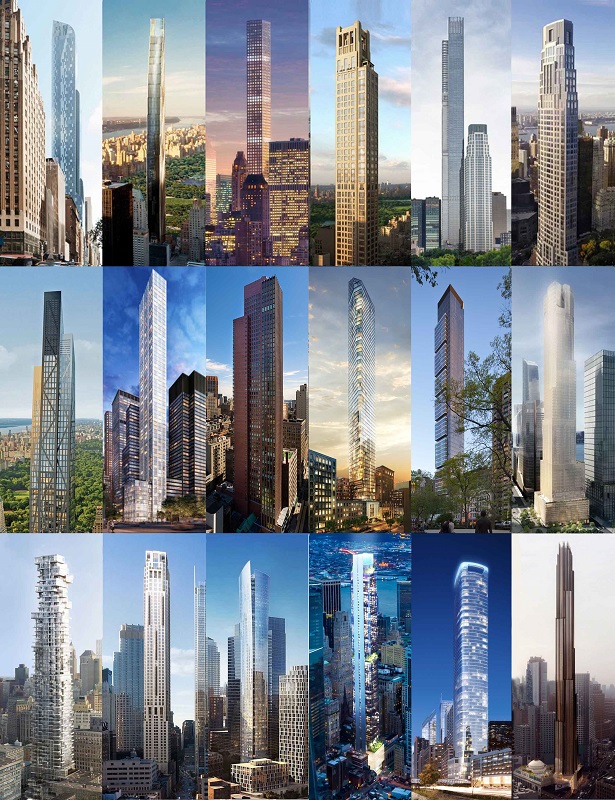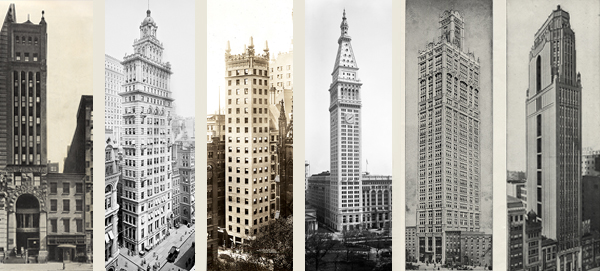Super-slender
Introduction
In June 2016, New York's Skyscraper Museum released an online tool that tracks the growing number of ‘super-slender’ towers in the city.
The interactive chart compares the heights and silhouettes of 18 'skinny' towers now complete or under construction in New York.
What is ‘super-slender’?
A new form of skyscraper has evolved in New York over the past decade: the super-slim, ultra-luxury residential tower. These pencil-thin buildings of 50-90+ storeys use a development and design strategy of slenderness to pile their city-regulated maximum square feet of floor area (FAR) as high as possible to create luxury apartments with spectacular views.
The defining characteristic of these new towers is not height, but slenderness. A tower can be very tall, but not slender, and it can be slender without being very tall.
Many developers believe apartment buyers shop first for neighbourhood, then views, then amenities. But in the new crop of super-slender towers, the views are the driving force. Central Park is the gold standard, but other areas also have great appeal if they can climb to 600-800 ft or taller and command sweeping panoramas of the city.
The above images of 18 slender towers are organised loosely by neighbourhood. The top row groups the best-known buildings near the southern end of Central Park and in particular on the cross-town commercial 57th Street, nicknamed ‘Billionaires’ Row.’
The middle row, which include four projects initiated before the 2008 credit crunch, are located in central midtown and midtown south near Madison Square, as well as 35 Hudson Yards.
The bottom row, of which three are topped out and completely clad are all in lower Manhattan, south of Chambers Street, with the exception of the last building, which will become the tallest building in Brooklyn.
Designed by 13 different architectural firms in a wide range of styles from historical to avant-garde and clad in materials from limestone to all-glass curtain walls, these towers underscore the slenderness development strategy as the unifying characteristic of a new typology.
What is slenderness?
‘Slenderness’ is an engineering definition. Structural engineers generally consider skyscrapers with a minimum 1:10 or 1:12 ratio (of the width of the building's base to its height) to be ‘slender’.
The World Trade Center North Tower was the tallest building in the world on its completion in 1971. But at a height of 1,368 ft and with a big square floor plate, 209 ft on each side, the ratio of its base to height was less than 1:7. The eighteen towers on the chart range from a ratio of 1:10 to an extraordinary 1:23 at 111 W. 57 Street.
Lining up the super-slenders by ascending height does not correlate to arranging them by their size in gross floor area (GFA). An extreme example is the difference in floor area of two tallest towers on the chart: Central Park Tower will comprise slightly more than 1 million sq. ft., while 111 West 57th Street will contain less than a third of that total. There is a more than five-fold range of size among the super-slenders: the two towers with the smallest floor areas - less than 200,000 sq. ft. - are 520 Park Avenue and One Madison.
History of slenderness in New York
New York City is the birthplace of the improbably slender tower. In the late 19th- and early 20th century, many tall shafts rose over high-priced lots. Indeed, it was the high value of the land and the potential offered by the technology of the elevator and steel-cage construction that made New York a city of towers.
There were three major stages and styles of slenderness in New York's high-rise history.
The first was a period of skyrocketing growth when, until the passage of the city's first zoning law in 1916, no municipal regulations constrained height. By 1909, the Metropolitan Life Insurance Tower rose 700 feet - 50 storeys - on a lot only 75 x 85 ft.
A second came in the 1920s. Shaped by the massing formula set by the 1916 zoning law, buildings with bulky pyramidal bases and slender soaring towers, covering no more than 25% of the lot area, became the new characteristic type of New York skyscrapers.
Because the 1916 zoning law applied to commercial buildings, including hotels, in the 1920s, the hotels that lined Fifth Avenue at the southeast corner of Central Park could sport tall and slender towers. The Pierre and Sherry Netherland illustrate both the enduring attraction of park views in the luxury life of New York that predict the new residential towers of the twenty-first century.
After 1961, a new zoning law set a limit on building height - or more accurately, imposed a maximum total floor area permitted on a given lot. It introduced a new formula, called the Floor Area Ratio (FAR). A developer can arrange the allowable FAR in any sort of massing, as some variations from the current zoning primer illustrate.
The 1961 law established the principle of ‘as-of-right’, which allows property owners to design and build whatever they wish without a public review process, so long as they follow zoning rules and do not exceed the maximum FAR allowed for that lot. It also created the concept of air rights, which permit an existing building that has not used all of the FAR allowed that lot, to sell the unused ‘air rights’ to the owner of an adjacent lot/s.
This mechanism, also known as ‘transferable development rights’ (TDRs), lets developers join lots to increase the FAR for a single site. However, when the under-built area of a lot is sold and used on an adjacent site, that low-rise space will then remain open forever. FAR is finite: it can only be used once. TDRs are a cap-and-trade system.
All of the super-slender towers use this method of assembling lots and transferring air rights to consolidate and concentrate their collective FAR into one tall tower. Developers generally demolish the under-built structures to create a larger site for their project, even if the tower will cover only a portion. At 432 Park Avenue, for example, the mid-block tower is only 93 ft sq. and is set back 60 ft from 56th Street and fronted by a plaza. A low-rise commercial building at the corner creates another zone of open space where the 22-story Drake Hotel once stood.
Images and content courtesy of The Skyscraper Museum



No comments:
Post a Comment